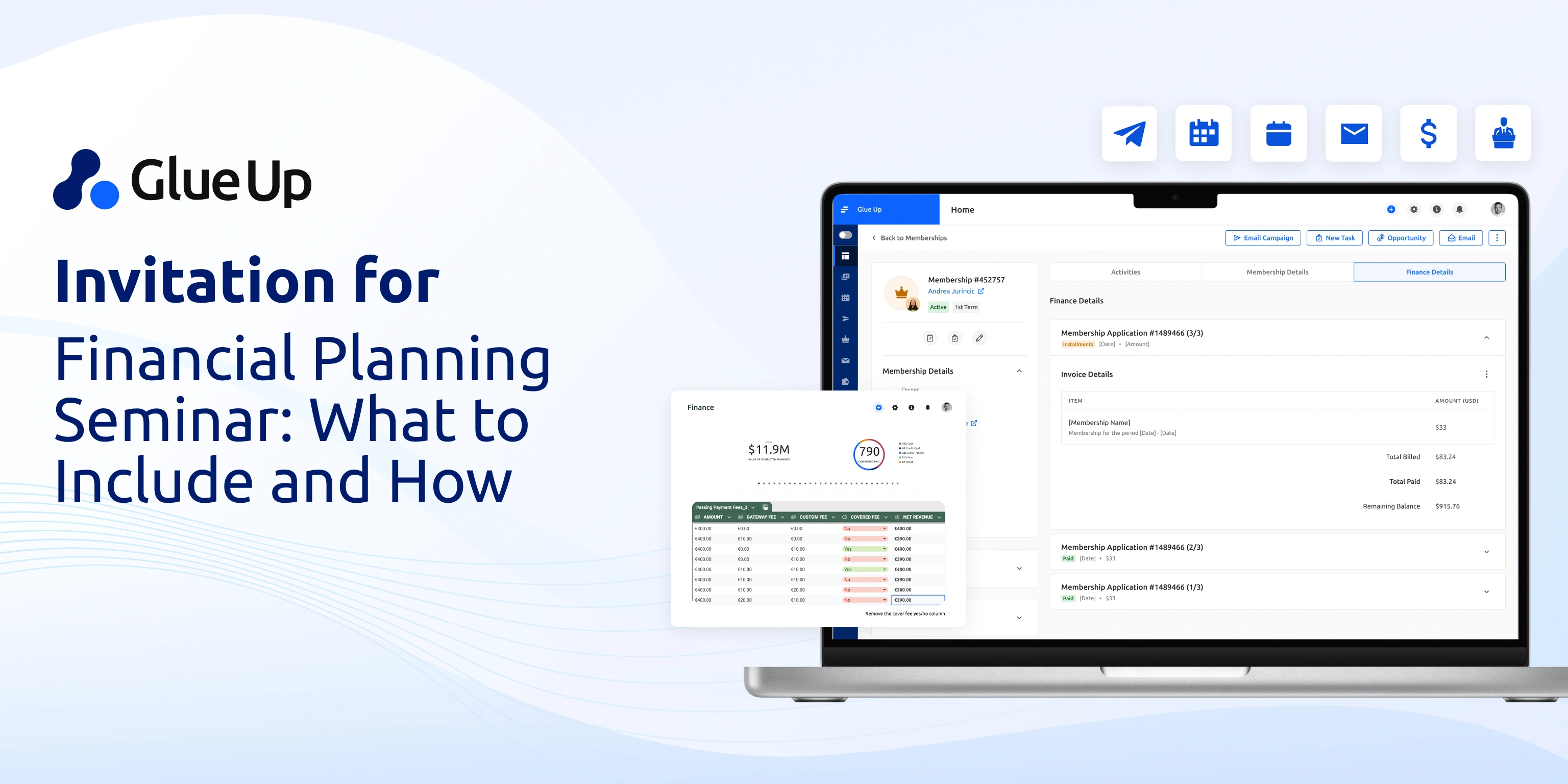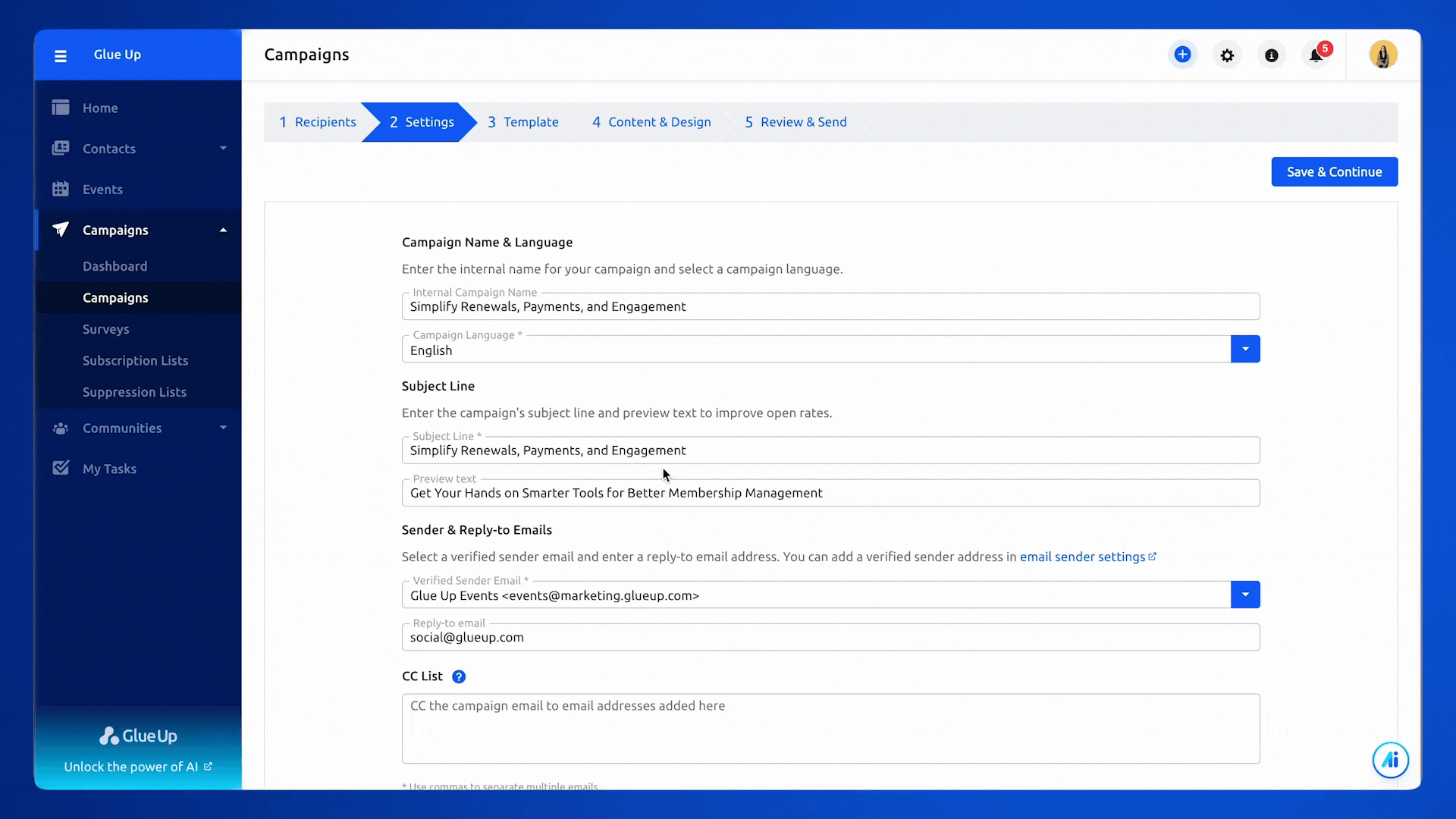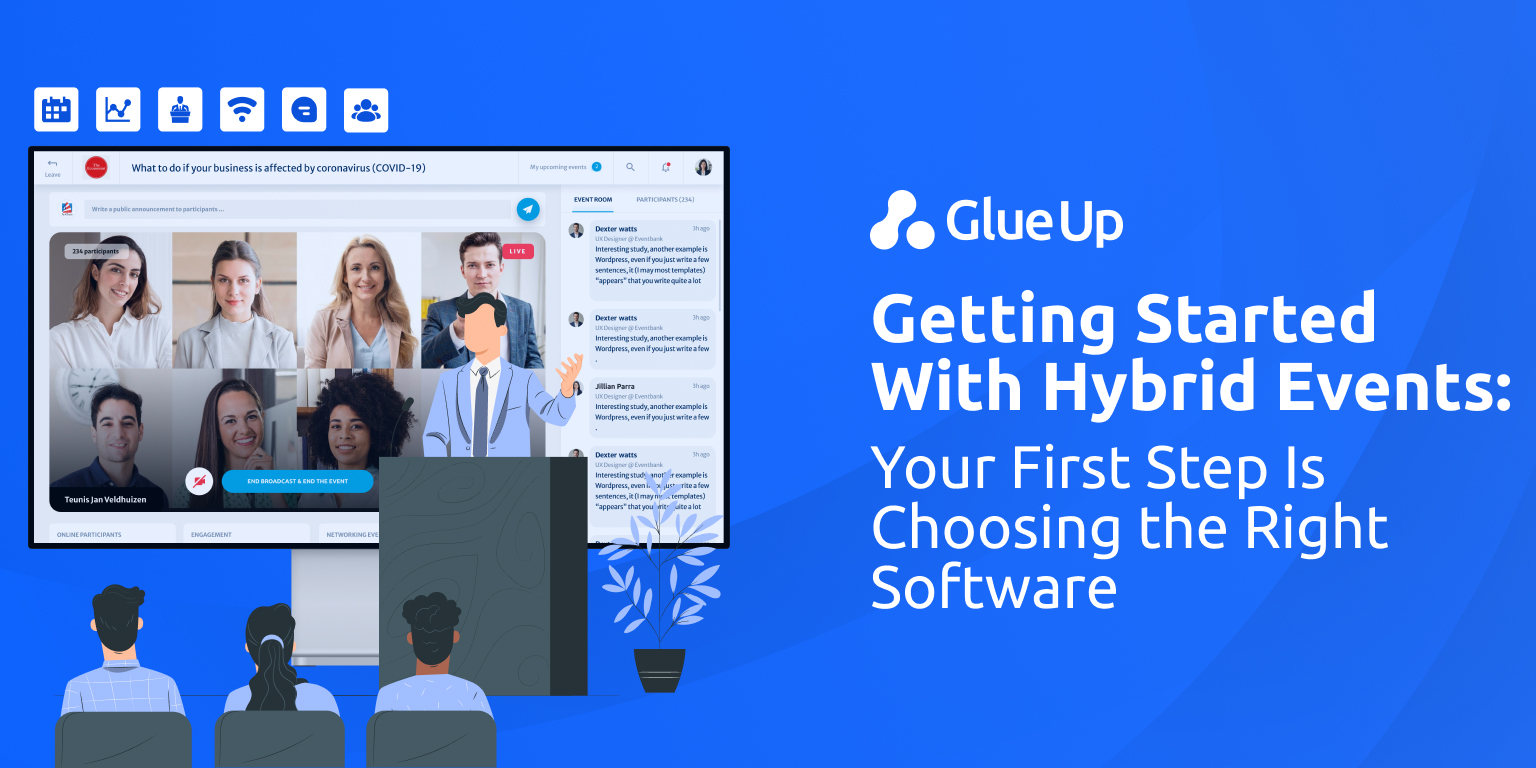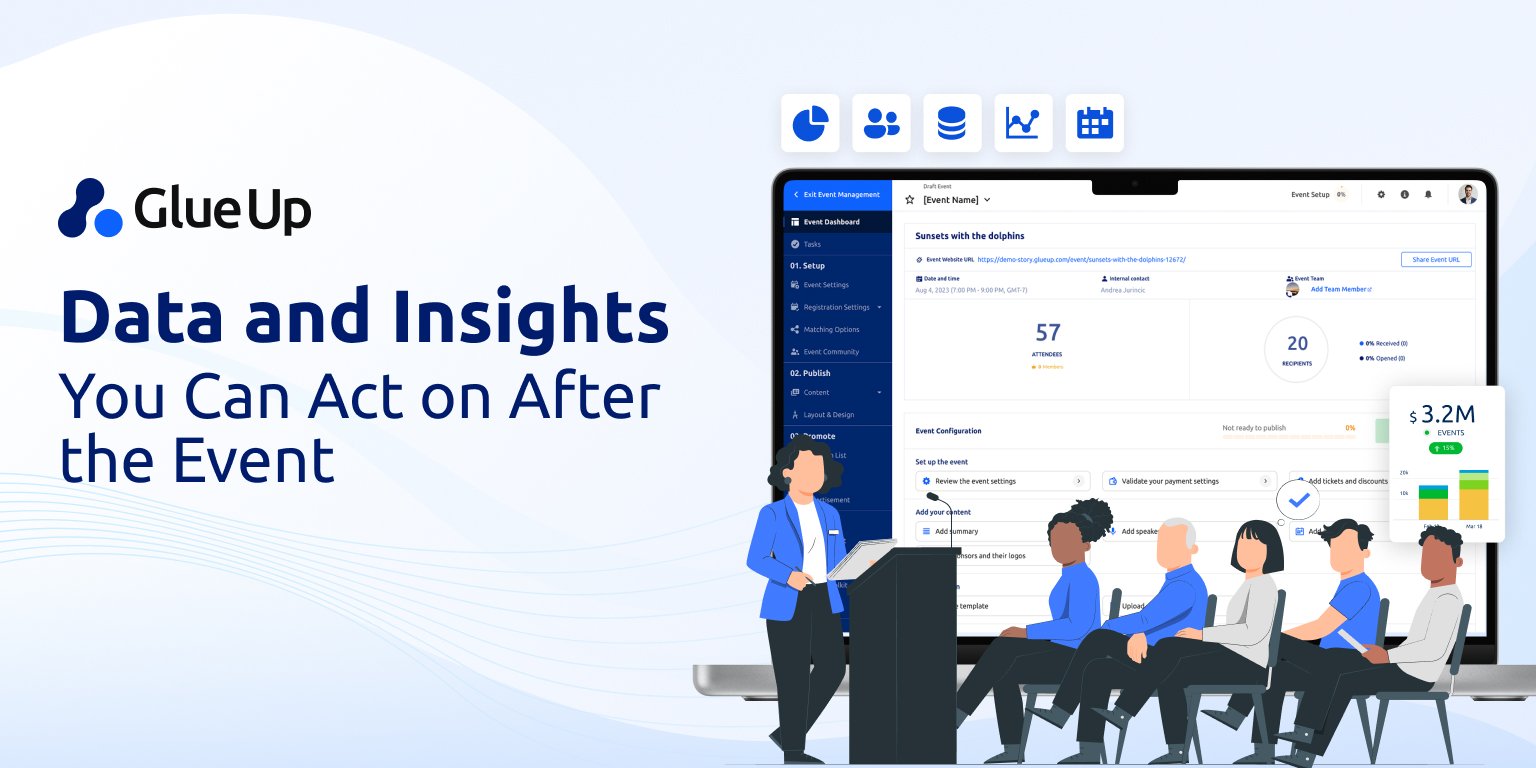
The success of a financial planning seminar begins long before the first presentation. For associations and chambers, these sessions are more than just another event. They provide members with direct guidance on managing money, planning for growth, and preparing for long-term stability. That's why a compelling invitation for financial planning seminar matters—it frames the value of the event and convinces busy professionals to make time for it.
Recent studies show that more than 9 in 10 professionals attend events when they believe the content will help them solve real challenges. Financial planning seminars fit that expectation perfectly, but only if the invitation clearly communicates what attendees will gain.
In this article, we'll define what financial planning seminars are, explain why strong invitations set the tone for success, and walk through the essential content, timing, and formats you can use to maximize attendance.
New to Glue Up? Send Smarter Seminar Invitations & Host Events in One Place
Thinking of sending a seminar invite? With Glue Up's email marketing software, you can create professional invitations that do more than look good. You can:
- Personalize each message with member or client details.
- Use Smart Lists to segment your audience so the right people receive the right invite.
- Track opens, clicks, and registrations in real time.
- Save time with AI Copilot, which helps you draft clear, targeted, and compelling invitations.
If you want every financial planning seminar invite to bring results, book a demo today. You can also use our event management software to manage every aspect of your event, from registration to email campaigns, check-in, invoicing, and more.
Key Takeaways
- A strong invitation for financial planning seminar builds credibility and drives attendance.
- Timing matters: send invites 4–6 weeks in advance for in-person and 2–3 weeks for virtual.
- Clear content—agenda highlights, speaker details, and CTAs—keeps members focused on value.
- Use multiple formats (email, digital invites, social media visuals, or print for VIPs) to reach different audiences.
- Glue Up's email marketing software and AI Copilot help associations create, send, and track invitations that turn interest into engagement.
What Is a Financial Planning Seminar?
We're sure most of your members aren't strangers to financial planning seminars. These events are widely recognized—nearly 70% of adults in the U.S. say they have sought financial education or planning resources at some point in their careers. However, what makes them stand out compared to other professional sessions is the immediate, practical value they offer.
At their core, financial planning seminars give participants tools they can apply right away: managing budgets, preparing for taxes, planning retirement, or navigating investments.
What to Expect From a Financial Planning Seminar for Associations and Chambers
For associations and chambers, these seminars open up opportunities beyond financial education. They help you:
- Provide Practical Value: Deliver actionable strategies members can apply immediately. For instance, a tax-focused seminar in Q4 could show small business owners how to optimize deductions before year-end.
- Bring in Trusted Experts: Featuring certified financial planners adds credibility. A chamber inviting a local CFP to present retirement strategies shows members you connect them with trusted advisors.
- Encourage Peer Learning: Seminars often include open Q&A or case studies. An association hosting a panel on investment basics could spark discussions between young professionals and experienced business leaders.
- Build Stronger Loyalty: Helping members with long-term goals fosters trust. For example, offering a budgeting seminar for first-time entrepreneurs demonstrates your organization supports their personal and professional stability.
In short, they're a smart way to deliver credibility, attract attendance, and show members that you're investing in their long-term stability.
What Is a Financial Planning Seminar Invitation?
If the seminar itself delivers the knowledge, the invitation is what gets people in the room. An invitation for financial planning seminar is more than a date and location. It's a communication tool that explains the value of attending, sets expectations for the session, and motivates members or clients to commit.
A strong invitation includes the basics—time, place, and speaker details—but it also answers the bigger question: Why should I attend? That means showing how the session will help attendees tackle real challenges, like preparing for retirement, tax planning, or managing business finances.
Think of it as both marketing and member service. The right wording makes your event stand out in a crowded calendar, while clarity and professionalism build trust with your audience.
Why a Compelling Financial Planning Seminar Invitation Is Important
Even the best seminar will fall flat if the right people never hear about it. A compelling invitation isn't just about filling seats; it's about signaling professionalism and showing members that the session is worth their time.
Research shows that 40% of professionals decide to attend an event based on the clarity and relevance of the invitation. For associations and chambers, that percentage can determine whether you deliver value to a handful of members or a packed room of engaged participants. Here's why your invitation matters so much:
- It Drives Attendance: A clear and engaging message shows potential attendees what they'll gain, whether tax-saving strategies for business owners or professional retirement planning insights.
- It Reinforces Your Credibility: A polished invite reflects the quality of your programming. For example, a chamber that sends a professional, benefit-driven invitation signals to members that the event will be well worth their time.
- It Aligns with Member Expectations: People have crowded calendars. When your invitation outlines outcomes—such as learning investment basics or avoiding common financial mistakes—it respects their priorities.
- It Opens the Door to Engagement: An effective invitation doesn't stop at registration. You can start building connections before the seminar by including clear CTAs and links, such as to your event management software.
For instance, if your chamber sends an invite highlighting how attendees will walk away with a step-by-step retirement checklist, members see the session as another meeting and an investment in their financial future.
Essential Content for Your Invitation
A financial planning seminar invitation should do more than announce logistics. It should give members an apparent reason to attend and make the registration process effortless. Here are the core elements every invitation needs:
- Clear Event Details: List the seminar title, date, time, location, and format (in-person, virtual, or hybrid). Confusing or incomplete details are a top reason people skip registering. See Nitrogen Wealth's guide for examples of how financial planning sessions are typically framed.
- Compelling Subject Line and Header: Your subject line or opening header is the first thing attendees see. Make it outcome-driven: "Plan Your Financial Future in 60 Minute" is stronger than "Financial Seminar Coming Soon"
- Speaker Information: Highlight who's leading the session and their credentials. Associations and chambers benefit when invites feature trusted experts like certified financial planners or tax advisors. Linking to speaker bios adds credibility.
- Agenda Highlights: Outline key topics, such as retirement planning, tax-saving strategies, or small business finance. Members want to know exactly what they'll walk away with.
- Strong Call-to-Action (CTA): Make registration easy with a visible, direct CTA like "Reserve Your Seat Toda". Tools like Glue Up's event management software let you embed CTAs that connect directly to your registration page.
- Visual Elements: Include professional visuals, such as financial planning seminar invitation templates or branded graphics. Visual clarity signals professionalism and boosts response rates.
- Contact Information: Always provide a point of contact for questions, whether by email or phone number. This small detail increases trust and accessibility.
For example, if your chamber invites local business owners to a "Year-End Tax Planning Seminar" outlining the topics in bullet points and including a photo of the featured CPA builds credibility and urgency.
Timing: When to Send Your Invitation
Even a compelling invitation loses its impact if it lands in inboxes too early or too late. Timing is one of the most overlooked parts of event promotion, yet it directly affects attendance.
Research shows that events promoted at least three weeks in advance see attendance rates 20% higher than those with shorter lead times. For associations and chambers, the sweet spot depends on your format and audience:
- In-Person Seminars: Send your first invitation 4–6 weeks before the event. This gives busy professionals enough time to schedule around it. Example: A chamber hosting a mid-year retirement planning workshop should announce it well before summer vacations.
- Virtual Seminars: Digital events require less lead time. Start invitations 2–3 weeks before and add reminder emails in the final week. For instance, an association running a "Small Business Tax Strategies" webinar in March could launch invites right after members receive tax-season updates.
- Hybrid Seminars: Treat these like in-person events with early invitations, but send additional digital reminders for virtual attendees in the final week.
- Reminder Cadence: One initial invitation isn't enough. Send at least three touches: the main invite, a reminder two weeks before, and a final "last chance" reminder 2–3 days before. Glue Up's email marketing software automates these reminders, ensuring you reach members consistently without extra manual work.
For example, a chamber promoting a "Year-End Financial Planning Seminar" could announce in early November, follow up mid-month, and send a last call the week of the event. This cadence keeps the seminar top of mind without overwhelming members.
Formats and Delivery Channels

A compelling invitation for financial planning seminar isn't just about what you say, but how you deliver it. The right format ensures your message reaches members where they already engage.
- Email Invitations: Email remains the most effective way to reach members directly. With tools like Glue Up's email marketing software, you can design branded invitations, personalize them by member type, and track open and click rates. Example: A chamber promoting a "Business Succession Planning Seminar" can segment messages so business owners get different highlights than individual professionals.
- Digital Invites: Digital invitation links or landing pages let you create a professional, shareable invite. Many associations use these alongside event registration pages built in Glue Up's event management software so members can register in just a few clicks.
- Printable Cards: While not as common today, printed invitations still carry weight for high-value audiences like corporate sponsors or VIP clients. Example: A chamber hosting an exclusive "Executive Financial Forecast Luncheon" could mail formal cards to board members or key partners.
- Social Media Visuals: Platforms like LinkedIn and Facebook amplify invites. Branded social media visuals paired with a registration link extend reach beyond your email list and encourage members to share with peers.
- Hybrid Approach: The most successful associations often use a mix: email as the core channel, supported by social media for visibility, and print for targeted high-value audiences.
Examples of Financial Planning Seminar Invitations
Every audience responds differently to invitations. That's why you should adjust tone, format, and delivery depending on your target audience. Below are a few examples you can adapt:
Email Invitation (General Members)
Subject Line: Secure Your Financial Future: Join Our Seminar
Body:
Hi [First Name],
You're invited to our upcoming Financial Planning Seminar on [Date] at [Location/Online]. This session will cover [key topics: retirement planning, tax strategies, or budgeting tools] and give you practical steps you can apply right away.
📅 When: [Date & Time]
📍 Where: [Venue or Online Link]
🎤 Speaker: [Name + Credentials]
Reserve your spot today and take the next step toward financial confidence.
👉 [Register Now]
Printable Card (VIP Clients or Sponsors)
Front: "Plan Today. Lead Tomorrow"
Inside: You're cordially invited to an exclusive Executive Financial Planning
Seminar hosted by [Organization Name]. Join fellow leaders on [Date] at [Venue] for an in-depth discussion on [topics].
Seats are limited. RSVP by [Deadline] to confirm your place.
Social Media Visual (LinkedIn/Facebook)
Headline: Unlock Your Financial Potential in 60 Minutes
Post Copy:
We're hosting a Financial Planning Seminar on [Date]! Learn from [Speaker Name] as they share strategies on [topics]. Perfect for business owners and professionals who want to take control of their future.
👉 Save your spot now: [Registration Link]
[Attach branded seminar visual or template]
Targeted Email (Small Business Owners)
Subject Line: Tax Strategies Every Business Owner Needs Before Year-End
Body:
Hi [First Name],
As a valued member of [Chamber Name],we'd like to invite you to a Financial Planning Seminar explicitly designed for small business owners. You'll walk away with tax-saving strategies you can apply before [Year-End/Tax Season].
📅 [Date & Time]
📍 [Venue or Online Link]
🎤 Speaker: [CPA or CFP Name]
👉 [Register Today]
Hybrid Event Invitation (Combination Email + Landing Page)
Subject Line: Join Us In-Person or Online: Financial Planning Seminar
Body:
Hi [First Name],
We know your schedule is busy, so we're making it easier to join our next Financial Planning Seminar. Attend in person at [Venue] or join virtually from anywhere. Topics will include [X, Y, Z].
Seats are limited—secure your preferred format today.
👉 [Register Here]
Turn Every Financial Planning Seminar Invitation Into Results
A strong invitation for financial planning seminar can be the difference between an average turnout and a room full of engaged members. By focusing on clear content, the right timing, and professional delivery, associations and chambers can position these seminars as high-value experiences that members don't want to miss.
If you're ready to make every invitation count, book a demo and see how Glue Up's platform helps you create, send, and track invitations that drive results.
FAQs About Financial Planning Seminar Invitations
How early should invitations go out?
For in-person seminars, send the first invite 4–6 weeks in advance. For virtual events, 2–3 weeks is enough, followed by reminder emails closer to the date.
What content is mandatory in the invitation?
Always include event details (date, time, format, location), agenda highlights, speaker credentials, and a clear call-to-action (CTA) to register.
Which format works best for invitations?
Email is the most effective for a broad reach, while printed cards work best for VIPs. Pairing email with social media visuals or digital invites ensures you cover all audience expectations.
How do I build urgency in my invitation?
Use time-sensitive language such as "Seats are limited" or "Register before [date]" Adding early-bird perks or exclusive access to resources can also motivate faster responses.
Can invitations be customized for audiences?
Yes. Segmenting invitations by member type or interest increases engagement. For example, business owners may respond better to tax planning highlights, while individuals prefer retirement planning tips. Tools like Glue Up's Smart Lists make audience segmentation easy.
Quick Reads
- Invitation Letter for Event: Samples, Templates & Examples
- Simplify Multi-Currency Payment Posting for Community Chapters With Glue Up + Paygage
- AI Automation for Event Registration & Beyond
- Integrating AI into CRM for Membership Growth
- How to Build a Chapter Event Calendar
- What Is All-In-One Association Software?
- AI-Powered Member Check-In Software



